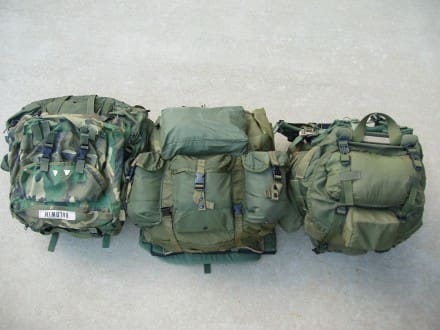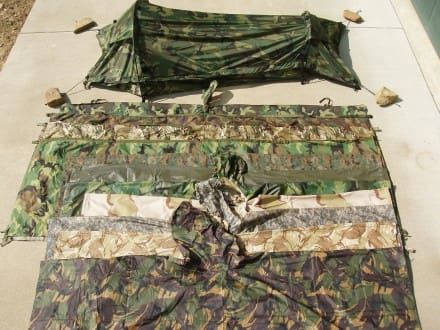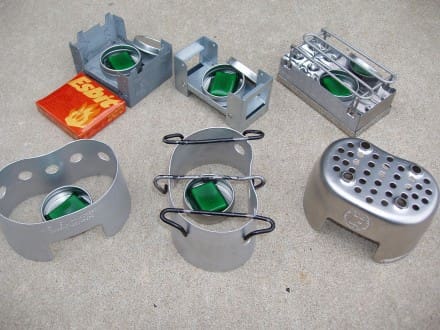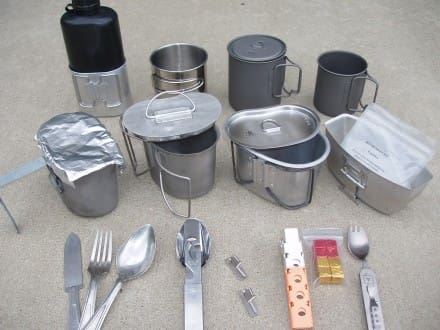In Part 2 we talked about modifications to the ALICE pack itself. In Part 3, I’ll focus on ALICE Frame and Suspension Upgrade options. It is fair to say that the weakest link of the ALICE pack system was the issue suspension system and the tubular aluminum frame. The LC-1 version of the frame was especially prone to breakage and Supply Sergeants had to keep a steady supply on hand for replacements. Especially in Airborne units where a number would be expected to be non-mission capable after each and every jump. The LC-2 version was reinforced and was indeed somewhat more durable but only to a point.
Arguably it wasn’t so much a flaw in the concept or the design but rather in the execution. It was the result of a deliberate compromise between strength, light weight and low cost. A couple of companies like Tactical Tailor and TAG make heavier duty metal frames for ALICE and ALICE clones. Both are welded rather than riveted like the issue frame. I have handled both and they do seem more robust and I have heard good things about them. However, as far as I know no Service has done any evaluations or issued any for rigorous troop testing. Nor have I used one personally. But if you prefer a metal frame to the newer non-metal versions then these would appear to be a significant improvement over the issue frame in terms of strength.
The search for a new frame for the ALICE packs goes way back. At least to the early 80s. Initiated not by the Army but rather by soldiers. The first candidate was the commercial Coleman pack frame. Individuals, myself included, experimented with using this frame in two ways. Some kept the frame intact. Instead modifying the ALICE pack itself with web tabs and grommets so that it could be attached to the frame just like the civilian Coleman backpacks. More of us actually cut the frame down with a hot knife so that it could be inserted into the envelope pad of the ALICE. This also reduced the length of the frame so that it was approximately the size of the issue frame. I used this cut down version for a couple of years. It was a little more comfortable than the GI frame. But it also tended to flex too much for my satisfaction when under load. So the search continued for a suitable replacement.
Other options were scarce for a long time. The Services began concentrating on internal frame designs like the CFP 90 in the late 80s. The tactical industry was quite small in those days. Some companies like Eagle made packs that utilized the ALICE frame but none were making modernized frames. And that didn’t change until the MOLLE System was developed in the late 90s. Some might not realize that, among other things, MOLLE was the last pack system that the USMC and the Army adopted concurrently. It also signaled at least a partial return to the external frame design. Although SOCOM’s SPEAR system was initially fielded about the same time. The first MOLLE pack frame had a ball and socket contraption that integrated the vest component to the pack component. That awkward innovation didn’t last long. MOLLE I was not well liked. And soldiers said so loudly in the AARs from the early engagements in Afghanistan in 2001-2. And the same was true of the SPEAR pack as well.
The initial reviews were so bad that shortly afterwards the USMC went a different way and tried the internal frame option one more time with the ILBE. The Army chose instead to issue a modified MOLLE II suite and has continued to update the base system ever since. The USMC eventually decided on an alternate external frame design called FILBE. MOLLE II now uses the DEI “GEN 4” 1603 frame and the FILBE uses their 1606 MC frame. I have a little personal history with the 1606 frame development. I was never issued the MOLLE rucksack but I did borrow one for a couple of days in early 2008 just out of curiosity. I immediately disliked the 1603 frame. I’m not a small guy but the frame was a little too wide to be comfortable for me and interfered with the natural movement of my arms. But I did like the concept and wondered if they had – or would be interested in producing – a smaller version. So I looked up the company and found they had just developed the 1606 which at the time came with a “hammerhead” rather than square top configuration. I asked if it would work on the ALICE? In response they sent me a sample. I think it was the only free piece of kit I ever received that I didn’t get from the government.
The hammerhead would not fit into the ALICE envelop pad. So I cut off and sanded smooth the ends so that it would fit. I provided a write up and some photos back to DEI explaining that if they squared off the head and made it compatible with ALICE and clones there would be a market IMO. They thanked me but said no thanks because they were concentrating on proprietary packs for the 1606 project and would continue in that direction. I kept using the 1606 I had modified and liked it a lot. Two years passed and I guess I wasn’t the only one that told DEI they were missing an opportunity. Because they started producing their 1606 AC (ALICE Compatible) version as well as the hammerhead 1606. Eventually they stopped production of the hammerhead all together. And, as they say, the rest is history. The 1606 was selected by the USMC for the FILBE and now for the Army’s Airborne 4000 pack as well as other commercial packs. The 1606 even works quite well on the Large MOLLE (top right). And of course the 1606 can be retrofitted to any ALICE or clone. If you still run one of those packs I would suggest the 1606 is well worth checking out.
After market shoulder straps or separate comfort pad sets started being produced and purchased by soldiers soon after the ALICE was fielded. The Army itself issued at least 3 different strap sets. The LC1 version had thin padding and only one quick release on the left strap. The LC2 had a thicker but shorter padded portion and dual quick releases. And finally, OD and woodland strap sets were produced that had better padding that extended the full length of the strap. However, inexplicably, that third set did not have sewn in attaching straps like its predecessors. A separate 1” strap was routed through a web bar on the shoulder strap to connect the padded portion to the ALICE frame. This arrangement was not an improvement. But that shoulder strap version did come with a sternum strap for the first time. Sternum straps are simple and very useful additions to any pack’s suspension and are ubiquitous on packs of any size today. Back then they were common on many of the after market strap sets or were fabricated by soldiers themselves for their ALICE packs.
HSGI used to produce what they called the Alipad (top center) and LBT still has a similar integrated suspension padding upgrade. I did not use the Alipad while on active duty because I liked having some open space between my back and the pack frame for ventilation. However, I have used it quite a bit in the last few years and have become more of a fan. Because it is a one piece design the Alipad “ties in” the suspension without adding too much bulk. In my experience there is a point of diminishing returns when it comes to added padding. Usually wider is better than thicker on the shoulders and lower back. However, this is an area when individuals definitely need to experiment themselves to find out what is right for them. One solution will not be right for all.
I’ll close by repeating some things I have already said. A “combat ruck” is any rucksack you have on your back when the shooting starts. A GOOD combat ruck is one that not only helps you carry the load but doesn’t make it harder for you to survive that encounter with the enemy. I again assure everyone that I am not, nor have I ever been, enamored with ALICE as issued. I have spent decades trying to improve ALICE for my own personal benefit if for nothing else. And I have eagerly tried every new wonder-pack that has come along in all those years. Always looking for something appreciably better for the direct combat role than ALICE. And I haven’t run into it yet.
Because despite its well cataloged shortcomings, I do believe the Large ALICE still represents the soundest design for a combat rucksack in terms of basic geometry. It does need modifications and modernization especially the frame and suspension as discussed in these last two articles. And I also believe that the Army would have been better served in the 80s if it had done what it has done with MOLLE. Concentrating on upgrading rather than fixating on replacing ALICE. CFP 90, SPEAR, ILBE and the other “better” packs didn’t fail because people were nostalgic or Luddites. Those packs failed because they weren’t really well suited to the mission. Much as the M16 has evolved over time into the M4 and countless individualized AR platforms. I would submit that ALICE is still a solid foundation or worthy template from which to build a truly better combat rucksack.
LTC Terry Baldwin, US Army (RET) served on active duty from 1975-2011 in various Infantry and Special Forces assignments.
Next: Cargo shelves and Pack Boards.























































































































